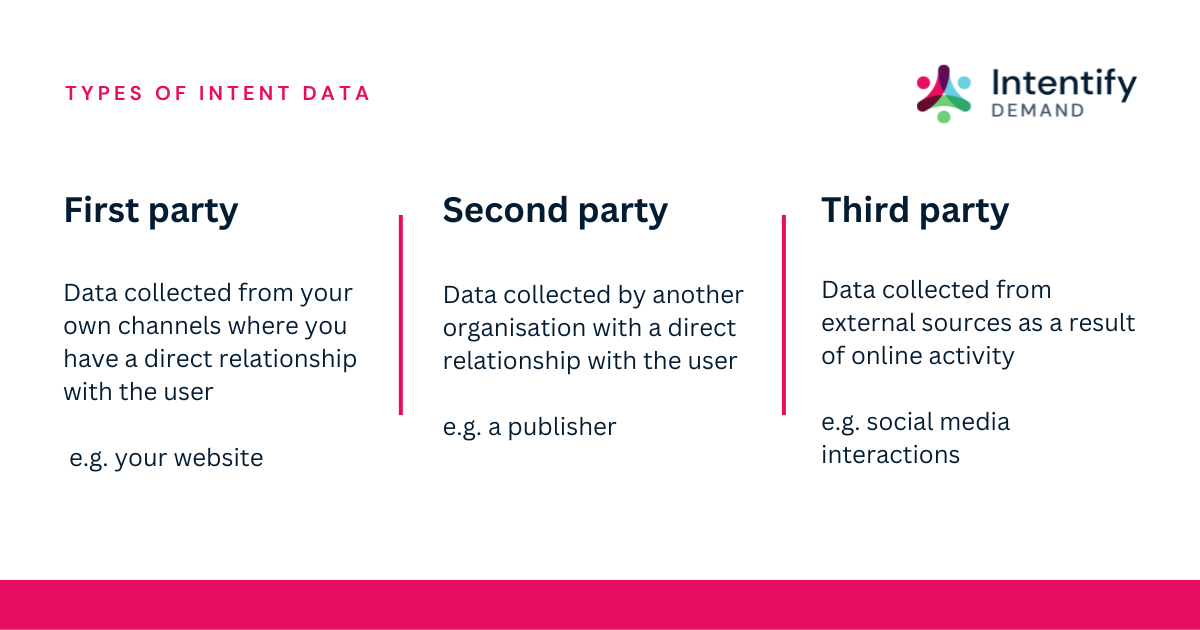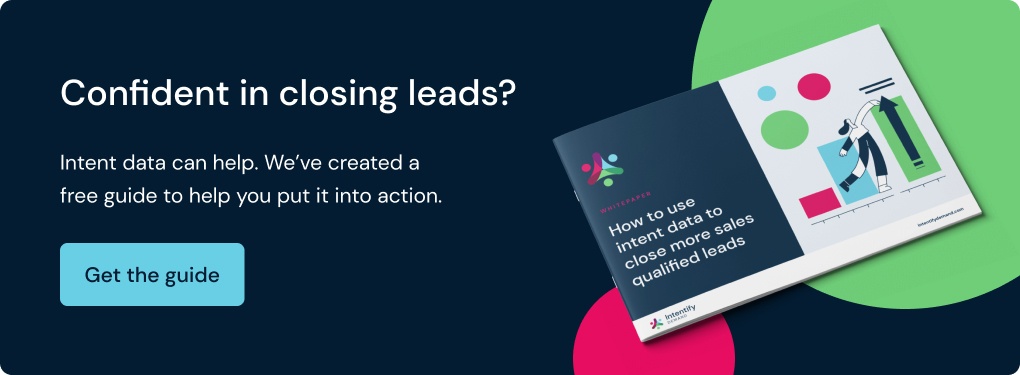Read time: 5 minutes
Conversion rates in the B2B space are notoriously low. In fact, according to research from Ruler Analytics, B2B technology companies only convert 2.3% of contacts.
This is what makes intent data so appealing. By focusing on prospects with a high purchase intent, companies can narrow down their targets, refine their marketing outreach, and increase their conversions.
However, not all intent data is equal. To help your efforts, rather than hinder them, you need to choose the right sources.
First party, second party and third party data: What's the difference?
There's no denying data is the lifeblood of marketing. But not all data is created equal. It's all down to who owns it and where it comes from:
- First party intent data is gathered from your own sources. This could be from your website or your social media channels.
- Second party intent data belongs to another company, but they share it privately with you. Essentially, you purchase another company's first party data.
- Third party intent data belongs to third-party companies, such as data aggregators. They collect data from an array of stitched-together sources and sell it on. You do not own or control this data.

Recommended reading: 26 intent data terms you need to know for B2B marketing
The risk of relying on third party intent data
Around 70% of B2B companies use third party intent data.
Despite so many B2B marketers relying on third party intent, this does come with a significant risk. Yes, third party aggregators typically offer more data from a larger pool of sources, but at what cost?
When you don't own the data, you can't be certain of its true intent or compliance. And so it's important to ask yourself whether you can trust this third party. Did the contacts opt in? How many contacts are actually demonstrating high intent?
If, for any reason, you can't answer these questions, it's a sure-fire sign your third party data provider isn't worth the risk.
Why we're only using first party data
We care about our contacts and our customers, which is why we use our own first party, intent-only data. This ensures:
- Full ownership. We have control over our data, meaning we can determine its source and relevance. We can also cull any data that doesn't meet our standards.
- High intent. We assign each dataset an intent score based on behaviours picked up by Pelago, our AI.
- Better data quality. Our data sits in a three-month quarantine period while we verify its accuracy.
- Data compliance. During the quarantine period, we also check for opt-ins. This confirms our contacts are willing participants.
Adds trust
High-quality data means you can trust the process and trust the outcome. We work hard to ensure each and every campaign gets the attention it deserves so it can perform to achieve the best outcome. Part of that is making sure our data is relevant and transparent.
Maintains compliance
It's easy to get caught up in data non-compliance when you don't know exactly where the data has come from. By using intent-only data, we can not only verify opt-ins, but it means peace of mind and guaranteed compliance for you. So no risk of a hefty GDPR fine.
Improves accuracy
Accuracy is crucial for marketing to be effective. Inaccurate data creates a number of issues, including misplaced personalisation - think Hello John instead of Hello Susan in your emails - and poor recommendations. All of which reduces the likelihood of a lead converting.
How to use buyer intent data to inform your marketing strategies
It's safe to say intent data is our thing. We know it like the back of our hand. And that also means we know how to use it, so here are a few quick tips to getting the most out of your own first party intent data:
Connect with qualified leads when they're doing research
Just because a lead isn't ready to convert doesn't mean they're not valuable. Your marketing funnel still needs filling out, so keep an eye on those who are coming to your site and are researching their pain points. There's a lot that can be said in delivering the relevant content at the right time.
Build a more accurate buyer profile
While many will say third party data is more useful because it's all-encompassing, there's something to be said for buyer data. And your first party data holds the key to who you are buyers are, what types of companies they work for and what their buying behaviours are like. So take the opportunity to build a detailed and accurate buyer profile based on the information you already have.
Create campaigns based on behavioural triggers
A generic newsletter once a month isn't enough to convince a prospect that they should buy from you. Instead, look at individual behaviours and ask yourself: 'What would they like to see next?' Then build out campaign sequences based on these behavioural triggers to help guide them further down the funnel.
Finally. Better quality leads you can trust
As intent data tools become more sophisticated, there will be even more areas of marketing that will be able to benefit from B2B buyer intent data. We're already seeing marketers use it to inform the sales cycle, fast-track the buying stage and guide marketing campaigns.
The B2B buying journey is often a long and complex one, with 61% of B2B buyers saying they consume 3-7 pieces of content before engaging with a salesperson. By concentrating marketing efforts and focusing on leads with a high purchase intent, marketers can fine-tune their strategy and spend time on what matters most.
And while that all sounds great in theory, the biggest drawback is often having access to the tech that can interpret levels of intent. Don't we all wish we could just have a clear-cut list of who's interested in buying? Why not get in touch today and see how we can help.
This article was updated 15th January, 2024



